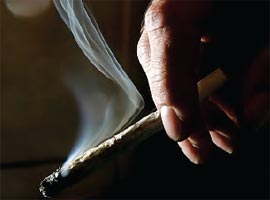
Cannabis has long been a potent symbol of rebellion for adolescents and young adults. It is the most commonly used illicit drug and controversy has always followed its use in contemporary Western society. This is partly due to its illegality but also because of its alleged medicinal effects and its use as a symbol of resistance to the oppressive nature of legal authority in these societies.
Interestingly though, a 2006 British Journal of Psychiatry report from the Netherlands where there are far more liberal laws with regard to its use, suggests that adolescents who regularly use cannabis are more likely to be aggressive and delinquent compared with peers who do not engage in regular use. Regular alcohol use was a confounding factor however, suggesting that regular psychoactive substance use may be a marker for aggression and delinquency in adolescence. A survey among COSTAAT (College of Science, Technology and Applied Arts of Trinidad and Tobago) students found that approximately 44% use psychoactive substances as a means to deal with stress.
The consecration of cannabis by Rastafarians and the evangelical defence of its use by universally popular Jamaican reggae artists like Bob Marley and Peter Tosh, and even Trinidad and Tobago’s Marlon Asher have served to legitimize and celebrate it. This in turn has contributed to the persistent debate about legalizing and/or decriminalizing its use.
 In ancient Indian and Chinese literature, cannabis was referred to as the sacred grass, used through centuries for medicinal and, presumably, its psychoactive properties. It only became illegal in the 20th century and there are various theories about what led to this designation driven by the ethos of a repressed pseudo religious morality. One of the postulated theories also suggests a socioeconomic agenda to disadvantage the developing countries where it is predominantly grown, but this requires more extensive study and it is surprising that more has not been written about it. In ancient Indian and Chinese literature, cannabis was referred to as the sacred grass, used through centuries for medicinal and, presumably, its psychoactive properties. It only became illegal in the 20th century and there are various theories about what led to this designation driven by the ethos of a repressed pseudo religious morality. One of the postulated theories also suggests a socioeconomic agenda to disadvantage the developing countries where it is predominantly grown, but this requires more extensive study and it is surprising that more has not been written about it.
In Trinidad and the Caribbean, it was introduced by the indentured migrants from India who used it in medicinal and religious rites. It remained legal until the 1950s.
It is said to have medical benefits in asthma, glaucoma and for treating intractable pain in terminal cancer patients and there is some research literature to support its use in these contexts, though mainly as derivatives. This has led to the legal availability by prescription in some states of the USA and in Canada for these purposes. Part of the problem with its illegality is the variability in purity and quality dispensed by its street dealers.
Its active psychoactive ingredient is delta-9-tetrahydrocannabinol (THC) and the medicinal varieties are clear about the amount and nature of the psychoactive constituents.
Like any other drug, it is not harmless. A recent review in Australia found that early initiation and regular use led to impaired mental health, lower educational achievement, risky sexual behaviour, delinquency and criminal offending. Recent studies in the USA suggest that teen use of cannabis predisposes to later depression in adulthood, a finding which has also been reported from Trinidad and Tobago. It is also associated with psychosis and schizophrenia, particularly first episode psychosis. In Trinidad and Tobago, at least three studies have confirmed that between 40-60% of first-admission cases for psychosis are related to cannabis use, particularly for males.
Another recent report from Britain suggested that high potency cannabis use was more likely to be associated with psychosis, especially in those who were daily users and had been using for over five years. The emphasis here is on the high potency, implying that the greater the presence of THC the greater the risk of psychosis as a result of use.
This vulnerability to developing psychotic reactions to cannabis seems to be a function of the genes we inherit for the enzyme (Catechyl-O-Methyl Transferase: COMT) which breaks down a certain group of chemicals in the brain called catecholamines. There are two amino acids that code for this gene and if you have the mixed methionine and valine polymorphic allele you are more likely to develop psychosis when exposed to THC. In other words, your predisposition for developing psychotic reactions to cannabis is dependent on the amino acid variant combination you have inherited.
 Evidence now suggests that it does have some addictive potential because it does stimulate the release of dopamine in the brain. The release of dopamine in particular areas of the brain is thought to be the final pathway to the development of addiction. The review from Australia noted that 10% of regular users would become addicted to the drug, perhaps another illustration of a genetic predisposition. This is less than for other drugs like cocaine and heroin but similar to alcohol. Evidence now suggests that it does have some addictive potential because it does stimulate the release of dopamine in the brain. The release of dopamine in particular areas of the brain is thought to be the final pathway to the development of addiction. The review from Australia noted that 10% of regular users would become addicted to the drug, perhaps another illustration of a genetic predisposition. This is less than for other drugs like cocaine and heroin but similar to alcohol.
It has long been associated with an amotivational syndrome which suggests that regular users lose their initiative and drive and tend to withdraw from active participation—and therefore contribution—to society. They spend most of their time smoking or seeking out cannabis. This may be the way addiction expresses itself.
Still cannabis continues to be used and it is likely that it has been used since antiquity, a point reinforced by the presence of cannabinoid receptors all over our bodies, including our gastrointestinal system. This partially explains why its use sometimes alters the eating behaviour of the user.
A variety of sensory experiences are enhanced by its use including body awareness and time dilatation. Sexual reactions may also be enhanced which is another incentive for use. Interestingly these are more powerful for women, while long-term use in men seems to diminish erectile functioning.
Andreas Zimmer and his colleagues in Bonn have also demonstrated that the body produces endocannabinoids which are important in the mediation of allergic, inflammatory and pain responses. This in part explains the medical uses of cannabis, which include treatments for glaucoma, vomiting, pain in cancer and HIV positive patients, and increasing appetite in those who are anorexic. There is active research trying to identify agonists and antagonists to these endogenous cannabinoids in order to generate a range of positive medical effects in many chronic diseases where there are intractable symptoms in the areas of pain relief, allergies and chronic inflammatory conditions.
The cannabinoid system is also a key mediator in the neurochemical mediation of fear and anxiety. The endocannabinoid system is a key modulator in the stress response pathways in the brain and is also involved with energy balance. When cannabis induces relaxation and a feeling of euphoria or well being, it is a function of its feedback relationship with the regulators of this system. However, in some users it paradoxically induces panic attacks, and this response may be genetically mediated.
These all indicate that like any other substance, there are both positive and negative issues related to its use but that some regulation and monitoring of its production and distribution is likely to be beneficial.
-Prof Gerard Hutchinson heads the Department of Clinical Medical Sciences at the Faculty of Medical Sciences, The UWI, St. Augustine Campus. Chrisl Thomas is a postgraduate student.
|





